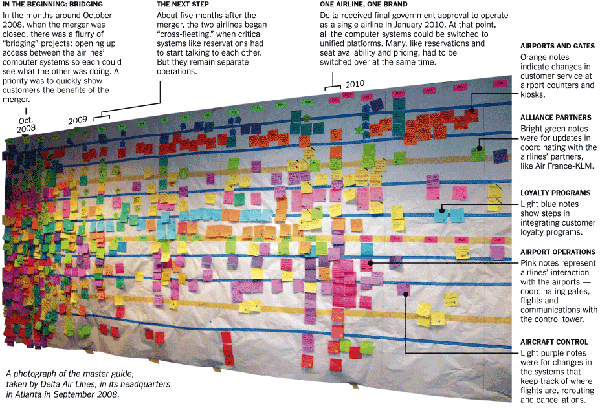
What works
As an image, this picture does an excellent job of supporting the argument made in the accompanying article, which is basically that merging two large companies, each with their own deeply embedded systems for handling passengers, planes, workers, and baggage as well as their own attitudes about how things should be done is a task nobody can understand until they attempt it. And then it becomes tedious almost immediately. The New York Times often saves clinchers for the end of the article and this one was a good one. Peter Wilander, an executive at Delta responsible for in-flight services (talk to this guy if you have a problem with the peanuts), cannot hide his frustration,
“The amount of work is boring beyond belief,” Mr. Wilander said. “It is also critical to the airline.”
What needs work
Is there anyone else out there who feels that if the PhD in applied mathematics is resorting to a merger by post-it, that there are real shortcomings in the system’s management abilities at Delta? Theresa Wise is Delta’s Chief Information Officer and the creator of this lovely Post-It art. While the post-its are both aesthetically pleasing and instantly graspable, I could not square the idea that a bunch of post-its stuck to a wall would really be the right answer to a problem like this:
A major switch happened when the new airline canceled all Northwest’s bookings and transferred them to newly created Delta flights in January 2010. It required computer engineers to perform 8,856 separate steps stretched out over several days.
Here’s hoping that my experience with Delta later today does not involve making seat assignments with Post-Its. For all of my snarkiness, I generally find Delta to be a good airline, better than the old Northwest.
References
Mouawad, Jad. (19 May 2011) Delta-Northwest Merger’s Long and Complex Path in The New York Times, Business Day Section. [Graphic How to Merge Two Airlines]

Comments 2
Mamie — May 19, 2011
I have to admit I was surprised at the author's characterization of the post-it organization as a sort of last resort by the directors of this merger. My father is a PhD in electrical engineering and a consultant in R&D processes for small tech firms. One of his usual techniques is to generate stacks of index cards, each with a task to be completed and color-coded according to timescale, for each team member. I had some experience in this technique when he imposed it in his self-declared role as "logistics director" for my sister's and my weddings, and it worked great. I'd always used physical organization techniques for complex processes before (pen and paper or whiteboard to-do lists and diagrams, index card outlines for papers to easily move elements and see what works best), and now I've added the index card tasks to my normal rota of coping strategies when I have something overwhelming to do.
One of the things that makes complex processes difficult is keeping track of the myriad tasks that need to be done, which tasks need to be completed before another can be tackled, and whether they've been completed. It can be grounding to have physical reminders of the tasks to be completed, and I find it easy to shuffle physical items like index cards or post-its when I change my approach to a project -- it interrupts my creative flow very little.
I suppose, then, the root of my surprise is that the post-it organization must have violated your expectations for how such a merger would be directed. To me, it made perfect sense -- but then, I am my father's daughter and I've never turned to more high-tech organization solutions for complex processes because the low-tech, physical solution has always worked for me. It's a first approach rather than a last "resort" to me. I'm curious what manner of organization would have seemed more appropriate to others.
designcourses — June 16, 2011
this graphics looks complicated, without prior knowledge on business it would be impossible to understand.